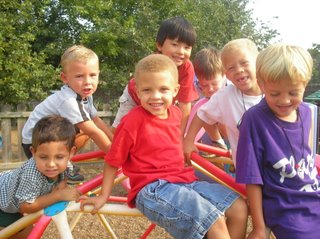
Recess, like any break is a time when children or anyone can absorb what they've learned, and begin again with a sense of "non overwhelming stress." As recesses have been shortened, so learning has become more difficult. It makes sense to lengthen recess again and see what happens. If all the testing is keeping children confined in an unnatural environment, then we need to ask what is more important, testing or play. We know we learn from play, but how many of us learn from tests?
Beaumont Enterprise.com
Some School Recesses Going Into Recession
By KRISTINA HERRNDOBLER, The Enterprise
Kountze Elementary School Principal David Erickson thinks recess just isn't what it used to be.
The importance of giving children a break so that they can come back to the classroom refreshed and ready to learn hasn't changed, Erickson said.But preparing every student for state and national testing sometimes means recess gets shortened or eliminated.
Kountze Elementary's recess from recess isn't the only one.Nationwide, school children are more cooped up than ever before, as nearly 40 percent of American elementary schools have either eliminated or are considering eliminating recess, according to the National Parent Teacher Association.
The National PTA and Cartoon Network have launched "Rescuing Recess," a campaign aimed to make unstructured play time a part of every child's school day.
Kountze Elementary, which houses pre-kindergarten through fifth-graders, has at least one scheduled recess period per day for most of its students. Pre-kindergarten and kindergarten classes have two 20-minute breaks a day.
Fifth-graders have one recess a week that lasts for 20 minutes in the months before state testing. The rest of the time, they get two 20-minute recesses per week."We don't have near what we used to," Erickson said. "It is the tests."
Before testing time, when teachers are working extra hard to prepare students, even the scheduled recesses can get canceled, he said. When that happens, the break is used to tutor children who are behind.
"With everything you have to teach in a given day, you look for every spare moment you can to help them pass (the tests)," Erickson said.
Once testing is over, recess continues so the students can blow off some steam, something Erickson said is essential.
Despite the nationwide cuts, a recent U.S. Department of Education study found that 83 percent to 88 percent of elementary school students still get nearly 30 minutes of recess a day.
But gone are the days of three recesses a day, said Rhonda Clements, a professor of education at Manhattanville College in Purchase, N.Y.
Clements, past president of the American Association for the Child's Right to Play, said a recess schedule that allows children to have play time in the morning, at lunch and in the afternoon is a proven success and should be revived.
"We have the early generation as the model for three recesses a day," she said. "They are very productive. They are creative thinkers, high achievers and inventive people.
"She said the current recess schedules give children a limited amount of time to become physically fit, spend time with their friends and practice their linguistic skills.
In many schools, recess has been replaced with physical education courses, which many states mandate.
In Lumberton, for example, students in grades four through six have physical education daily, but not recess.
Olga Jarrett, an early childhood education professor at Georgia State University, said recess and P.E. are not interchangeable.
"They serve different purposes," she said. "P.E. can provide some of the fitness needs of children, but it doesn't provide for the social needs."
She said children are not as active during P.E. because they often are standing in line. Moreover, it is a graded class, where students are told what to do, how to play and with whom to play.
During recess, children can make their own choices about these things, she said.Recesses should be scheduled at times that actually give children a break from studying, Jarrett said. They should not be scheduled too early in the day or too close to the end of the day, she said.
Lumberton students in pre-kindergarten, kindergarten and grades one through three get 20 minutes of recess a day, according to Lumberton ISD.
Lumberton Early Childhood school Principal Margaret Cruse said free time plays a vital role in the educational process.
"They really need that time to enjoy each other and get their minds off the classroom," she said.
"I feel like an active body produces an active mind."In Beaumont, there are no district-wide requirements on recess. It's up to principals to decide when recesses will occur and their duration, said Rodney Saveat, director of athletics, health and physical education for Beaumont ISD.
Sallie Curtis Elementary Principal Nancy Loyd said she requires recess daily for every child.
Recess is scheduled for 30 minutes, so even if students need extra tutoring or a short time-out, they still will have at least 15 minutes to play outside.
"There is always more than what you learn in books here at school," said Scotti Nordstrom, a third-grade teacher at Sallie Curtis. "The playground is a good place to learn those things."kherrndobler@beaumontenterprise.com(409) 880-0737

No comments:
Post a Comment